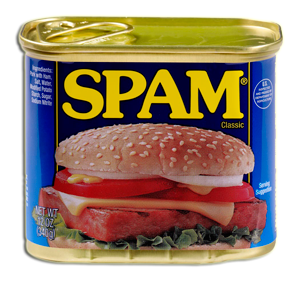Yet, with the advent of the Internet, the concept of unwanted interruption took on a much darker form – Spam! When viewers choose the content they consume, anything that arrives without consent risks alienation. The Internet is a content rich repository and the viewer’s eyes are a valuable commodity. Few content providers want to risk losing a viewer – or potential customer – to Spam.
For companies marketing online, the burning challenge becomes: how to reach prospects you don’t know without crossing the line called Spam.
The most common solution was to optimize your website so it ranks high in all search engines. This quickly resulted in ‘spam like’ activity that forced search engines like Google to redefine their search formulas. Online advertising has caught on, but much of that is either expensive, ineffective, or annoying – or all three.
Our approach to generating opportunity in cold markets (ok, let’s call it what it is, effective spamming) is to understand the process of gaining permission to market your services. We believe that by growing permission, it is possible to harvest great prospects from cold contact lists. Here are some of the ways we manage the process of warming relationships:
Bulk Email Campaigns. Effectively marketing to a blind list of bulk email recipients requires time and patience. It starts by creating eye-catching headlines that focus on your prospect’s pain – not your product. After your initial mailing, a series of follow up messages is recommended for any contacts that either open or click your offer. Most cold lists have less than 1% to open rate, but with low delivery costs, that conversion rate can be offset by volume.
Long Form Sales Marketing. This is a tried and true staple of Internet marketing. It is the sales letter that goes on and on (and on…). While we don’t recommend this for known prospects, the long form sales letter is a great way to tell the story of your product, gain credibility by using testimonials, and explaining features and benefits to prospects who do not know you. Long Form Sales Letters can be optimized for Internet search or used as part of a bulk marketing campaign.
The Lead Magnet. If you are marketing to a ‘cold’ audience (much nicer term than Spam, don’t you think) realize that you will most likely NOT sell your primary product until you’ve developed more of a relationship with your prospect. Having a free offering that your new prospect can receive in exchange for their contact information allows you to continue the conversation and grow your relationship.
Customer Relationship Management. Understand that every person who comes into contact with you wants to feel like they matter. Understanding who they are, what they value, why your company or product is relevant to them allows you to grow your relationship much more effectively. It starts by knowing your core audience and developing messaging channels for them. This allows you to measure their interest and engage them when they exhibit buying behavior. It also allows you to leave them alone when that is their preference. They will reward you for knowing the difference.
If these topics are of interest, we have several workshops and webinars that explore these topics in more detail. Click here for our latest workshop

